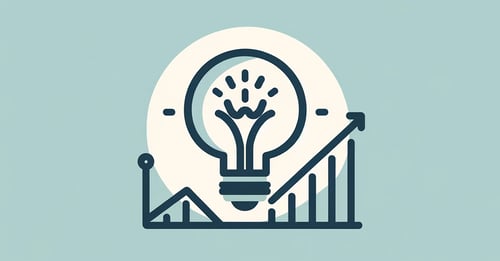As a company, do you understand your clients' needs? How do you plan on making your prospect or client know and relate with the product or services you are offering, and how do you plan on out-beating your competitors and being seen as an authority in your industry?
The answer lies in how much you know about Demand Generation and how you are using it to your advantage.
Demand Generation is about creating and boosting awareness for your products or services, essentially creating demand.
However, it's important to note that this strategy isn't only focused on generating immediate leads. Instead, it's about intentionally positioning your company offerings in a way that potential customers learn about what you have to offer.
The key to successful Demand Generation is making sure your brand is visible in places where your potential customers are most likely to engage with it.
For example, if you are selling organic coffee beans, you wouldn't promote them in an electronics store, would you?! Instead, you would opt for a local coffee shop or a place where you are sure to find good customers.
So, what exactly is Demand Generation? How does it differentiate itself from similar concepts such as lead generation?
Furthermore, what strategies and benefits are associated with effective Demand Generation campaigns?
In this article, we will dive deep into the importance of Demand Generation, exploring its definition, differentiating it from other marketing practices, understanding its strategic implementations for B2B companies, and illustrating its great impact on sustainable business growth.

What is Demand Generation?
Demand Generation is a marketing and sales strategy that includes any activity or awareness that creates customers' interest in a company’s products and services.
Unlike a singular marketing approach, Demand Generation involves different steps designed to build and nurture prospect relationships over time.
From brand awareness and inbound marketing to lead nurturing and sales enablement, every activity under the Demand Generation umbrella aims at generating a sustainable pipeline of business.
Demand Generation vs Lead Generation
Demand Generation and lead generation are important tools for companies looking to grow their product and service offerings. While they are sometimes mixed up, they have different goals, tactics, and results.
Knowing these differences is important for using resources well and getting the most out of marketing investments.
Even though both are important in marketing, they focus on different parts of getting customers.

Demand Generation
Demand Generation's primary aim is to build and develop customer relationships over a period of time, building trust and educating the market about the value the company provides.
And it is a long-term, endless process that focuses on attracting a large audience and guiding potential customers through the sales funnel, from the first time a prospect becomes aware of an offering, to interest, and finally, to purchase.
Why is Demand Generation important?
- Building Brand Awareness
This increases the visibility of your brand and educates the market about the solutions your company is offering. - Market Education
Market education helps potential customers understand the problems they face and how the company’s products and services can solve those problems. - Relationship Building
This involves walking customers through all the stages of the buyer’s journey, building trust and loyalty. - Long-term Growth
By building strong relationships with customers, sustainable bonds and growth will be established.
Lead Generation
Lead generation, on the other hand, is more targeted and focused on converting interest into action—namely, getting customers information (leads) for follow-up.
The goal is to identify individuals who have shown interest in the company’s offerings and are potential prospects that can be converted into customers.
Why is Lead Generation Important?
- Sales Pipeline
Lead generation fills the sales pipeline with potential customers, which can lead to an increase in revenue. - Targeted Approach
Lead generation gives room for a more focused approach, targeting individuals who have shown a clear interest in a company’s products or services. - Efficiency
Lead generation allows for more efficient use of sales and marketing resources by pointing out leads with higher conversion potential. - Measurement and ROI
It makes it easier to measure marketing efforts and calculate return on investment (ROI) by tracking how leads convert into paying customers.
Difference and Integration
While the goal of Demand Generation is to create interest in the company and its solutions, leading to an informed and engaged audience, lead generation is more focused on capturing the data or information of prospects who have shown a specific interest in buying or learning more.
In essence, Demand Generation sets the stage and builds the audience, while lead generation identifies and extracts potential customers from that audience.
Integrating both strategies is important for a successful marketing and sales campaign.
Demand-generation activities build the;

B2B Demand Generation
The goal of every B2B company is the sales or patronage of their products and services. To achieve this, their prospects need to be aware of and show interest in what they are offering. This is where B2B Demand Generation comes in.
Unlike B2C marketing strategies, which often focus on quicker, emotion-driven buying decisions, B2B Demand Generation must navigate longer sales cycles, multiple decision-makers, and a need for a high level of trust and credibility.
This strategy contains different types of activities designed not only to attract potential customers, but also to nurture those prospects through the sales funnel until they are ready to become paying customers.
What are the features of B2B Demand Generation?
- Content Marketing
At the heart of B2B Demand Generation is content marketing. Informative and engaging content, such as whitepapers, blogs, infographics, and videos, play an important role in attracting potential buyers.
With content that addresses specific industry issues and offers solutions, the company will be positioned as a thought leader. - Search Engine Optimization (SEO)
To ensure that the content reaches its intended audience, B2B companies must invest in SEO. By optimizing content for relevant keywords and phrases, companies will improve their visibility when being searched, making it easier for potential buyers to find their solutions. - Social Media Marketing
B2B companies using social media platforms like LinkedIn, Twitter, and industry-specific forums to share content will have a chance of engaging with prospects and building communities.
Social media enables companies to display their expertise and engage directly with their audience in a way that connects with their needs. - Email Marketing
Email remains a powerful tool that B2B companies can take advantage of.
Through personalized email campaigns, companies can nurture leads by providing them with targeted information over time, keeping the brand top-of-mind, and moving prospects through the sales funnel. - Pay-Per-Click (PPC) Advertising
PPC campaigns on platforms like Google AdWords and Bing Ads can complement other advertising or marketing efforts by targeting specific keywords and audiences.
These campaigns can quickly generate visibility and traffic from potential buyers actively searching for related products or services. - Lead Nurturing and Scoring
An important part of Demand Generation is not just attracting leads but also converting them.
By using lead scoring, companies can prioritize leads based on their engagement level and likelihood to buy, tailoring the nurturing process to move high-priority leads closer to a buying decision. - Analytics and Measurement
Demand Generation efforts need to be constantly analyzed and refined.
By closely monitoring key performance indicators (KPIs), such as; website traffic, lead generation rates, conversion rates, and ROI, businesses can understand what's working and make informed adjustments to their strategies.
Challenges and Considerations
B2B Demand Generation has its difficulties. The long and complicated sales cycles, along with the need to reach many people, businesses must have clear and consistent messages everywhere.
Also, with the fast-changing digital world, companies need to keep current with new marketing tools and platforms.
To overcome these challenges, B2B companies must focus on understanding their audience deeply, delivering value at every engagement, and leveraging data and technology to streamline and optimize their Demand Generation efforts.
Growth Marketing vs. Demand Generation
Growth Marketing and Demand Generation are two ways businesses boost their market presence, sales, and long-term success.
Even though they both aim to improve business performance, they use different methods and focus areas. Knowing these differences helps marketers choose the best strategies for their business goals.
While Growth Marketing adopts a wide lens, seeking growth at all customer lifecycle stages, Demand Generation zeroes in on the initial stages, seeking to cultivate interest and leads.

Key Differences Between Growth Marketing and Demand Generation
Objectives
Growth marketing looks at the entire lifecycle of a customer, aiming to optimize and leverage every touchpoint to drive retention and loyalty.
Demand Generation, on the other hand, primarily focuses on generating interest and educating potential customers to create a pipeline of qualified leads.
Scope and Approach
Growth marketing employs a holistic and experimental approach, integrating product tweaks and customer experience improvements into its strategies.
Demand Generation is more straightforward and linear, concentrating on specific tactics to attract and nurture leads until they are sales-ready.
Metrics
The metrics for assessing success also differ. Growth marketers usually look at a broader set of metrics that cover acquisition, activation, retention, referral, and revenue.
Demand Generation professionals focus on lead quantity and quality, conversion rates, and ultimately, the impact on the sales pipeline and revenue.
Tactics
While both strategies employ content marketing and online engagement, growth marketing includes more innovative and technology-driven tactics like app development or advanced analytics.
Demand Generation leans towards established lead nurturing and management tactics, such as; email marketing campaigns, webinars, and high-quality content creation.
Though different, growth marketing and Demand Generation can work together. Combining the broad, trial-and-error methods of growth marketing with the focused, lead-centered tactics of Demand Generation can be very effective.
For example, what companies learn from growth marketing experiments can improve and inform Demand Generation strategies, making them better.
Likewise, the emphasis on good leads and nurturing in Demand Generation helps companies figure out how to keep customers happy for a long time.
Demand Generation Metrics (Key Performance Indicators)
To measure the effectiveness of Demand Generation efforts, companies can use different Key Performance Indicators (KPIs).
Some important metrics include:
- Lead Generation
Lead Generation is the total number of leads generated over a specific period. This metric is important for assessing the success of marketing and sales campaigns. - Cost Per Lead (CPL)
CPL evaluates how cost-effective marketing and sales campaigns are in acquiring new leads. It is calculated by dividing the total spend on a campaign by the number of leads generated. - Lead Conversion Rates
Marketing Qualified Lead (MQL) to Sales Qualified Lead (SQL) Conversion Rate measures the percentage of MQLs that are considered ready for the sales team's engagement. High conversion rates indicate effective lead qualification processes. - Lead to Customer Conversion Rate
This metric tracks the percentage of leads that eventually become paying customers. This KPI helps assess the overall effectiveness of both marketing and sales funnels. - Content Engagement
Page Views and Unique Visitors offer insight into the reach and attractiveness of your content. High numbers suggest good engagement, but quality and relevance are also crucial. - Click-Through Rate (CTR)
CTR is the ratio of users who click on a specific link to the number of total users who view the page, email, or ad. It measures the effectiveness of calls-to-action and how important content is. - Bounce Rate
The bounce rate is the percentage of visitors that moved away from your site after viewing only one page. Lower rates indicate more engaging and relevant content. - Campaign Performance Return on Investment (ROI)
This calculates the profitability of marketing and sales campaigns by comparing the net profit to the costs. It helps justify how much was spent on marketing and guides budget allocations. - Customer Acquisition Cost (CAC)
CAC shows the total cost it took to acquire a new customer, considering all marketing and sales expenses. Lower CAC indicates higher efficiency in marketing campaigns. - Customer Value Metrics
Customer Lifetime Value (CLV) predicts the total value a company can expect from a single customer account. Increasing CLV indicates that customers are finding value in your offerings and remain loyal. - Customer Retention Rate
This measures the percentage of customers that a company retains over a specific period. High retention rates suggest successful post-acquisition engagement strategies. - Channel Effectiveness
Traffic By Channel understands which channels (e.g. organic search, social media, and email marketing) that are most effective at driving visitors to the company's website, offering insights into where to focus efforts. - Lead Generation By Channel
This identifies which channels are not just driving traffic, but are also effective at converting visitors into leads, helping to optimize channel strategy.
By consistently tracking these KPIs, companies will gain valuable insights into how effective their Demand Generation strategies are.

Examples of Demand Generation
Innovative approaches to Demand Generation marketing have proven successful for businesses willing to think outside the box and go the extra mile.
Let's check out a few notable examples:
Educational Content
This involves creating valuable, informative content not directly promoting a product, but designed to educate the target audience on relevant topics.
HubSpot is a prime example of this approach, offering an array of free resources that, while beneficial on their own, also generate demand for their marketing tools.
Interactive Tools
Developing tools or calculators that provide immediate value to the user can generate significant interest and demand.
For instance, the mortgage calculator by Zillow has become an indispensable tool for home buyers, simultaneously driving traffic to their site.
Influencer Partnerships
Collaborating with influencers that connect with the target audience can amplify Demand Generation efforts. A partnership between a brand and an influencer can bring a product or service in front of a dedicated following in an authentic and engaging manner.
Demand Generation Marketing Strategies
Before companies can have a successful Demand Generation Marketing campaign, several strategies need to be implemented:
Targeted Content Marketing
Creating and sharing quality content tailored to the needs and interests of a defined audience. This method ensures that the content resonates with the audience, thereby increasing engagement and interest.
SEO & SEM
Optimizing content for search engines and leveraging paid search advertising can dramatically increase visibility and attract more leads.
Email Marketing Campaigns
By sending targeted and personalized email campaigns to prospects, companies can nurture leads and gradually convert them into customers.
Social Media Campaigns
Utilizing social media platforms to engage with potential customers, sharing valuable content, and running targeted ads can significantly boost demand.
Event Marketing
Hosting or participating in events (both virtual and in-person) can provide a direct platform for engaging potential customers and generating interest in your offerings.
A successful marketing campaign requires a detailed strategy that combines various tactics to engage, educate, and convert the target audience.
By leveraging content marketing, SEO, social media, email, influencers, paid advertising, and interactive events, companies will be able to create a multi-faceted strategy that not only generates demand, but also builds lasting relationships with customers.
Remember, the key is to provide consistent value and remain adaptable to the evolving needs and behaviors of the market.
In conclusion, by embracing Demand Generation, businesses not only brighten the path for potential customers, but also lay the foundations for long-term prosperity and significant growth.


Comments